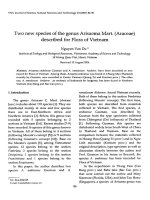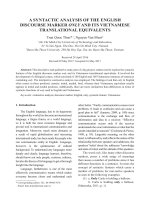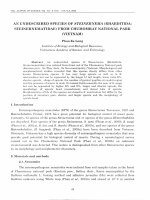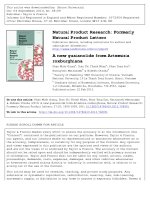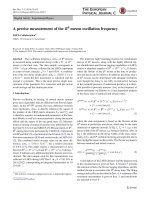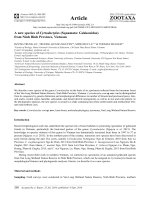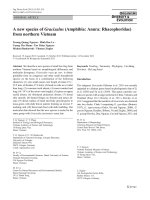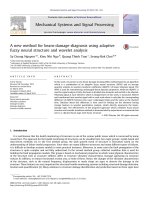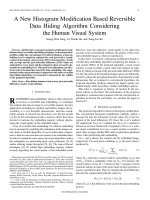DSpace at VNU: A new species of Gracixalus (Amphibia: Anura: Rhacophoridae) from northern Vietnam
Bạn đang xem bản rút gọn của tài liệu. Xem và tải ngay bản đầy đủ của tài liệu tại đây (774.94 KB, 12 trang )
Org Divers Evol (2013) 13:203–214
DOI 10.1007/s13127-012-0116-0
ORIGINAL ARTICLE
A new species of Gracixalus (Amphibia: Anura: Rhacophoridae)
from northern Vietnam
Truong Quang Nguyen & Minh Duc Le &
Cuong The Pham & Tao Thien Nguyen &
Michael Bonkowski & Thomas Ziegler
Received: 19 August 2012 / Accepted: 18 October 2012 / Published online: 14 November 2012
# Gesellschaft für Biologische Systematik 2012
Abstract We describe a new species of small tree frog from
northern Vietnam based on morphological differences and
molecular divergence. Gracixalus waza sp. nov. is distinguishable from its congeners and other small rhacophorid
species on the basis of a combination of the following
characters: (1) size small (snout-vent length of males 27.1–
32.9 mm, of females 37.6 mm); (2) head as wide as or wider
than long; (3) vomerine teeth absent; (4) snout rounded and
long (16–18 % of the snout-vent length); (5) spines on upper
eyelid absent; (6) tibiotarsal projection absent; (7) dorsal
skin smooth; (8) dermal fringes on forearm and tarsus absent; (9) dorsal surface of head and body greyish-green to
moss-green with dark brown pattern forming an inverse Y
marking; and (10) throat and chest with dark marbling. Our
molecular data showed that the new species is nested in the
same group with Gracixalus jinxiuensis sensu lato.
T. Q. Nguyen : C. T. Pham
Institute of Ecology and Biological Resources,
Vietnam Academy of Science and Technology,
18 Hoang Quoc Viet,
Hanoi, Vietnam
T. Q. Nguyen (*) : M. Bonkowski
Department of Terrestrial Ecology, Cologne Biocenter,
University of Cologne,
Zülpicher Strasse 47b,
50674 Cologne, Germany
e-mail:
M. D. Le
Faculty of Environmental Sciences, Hanoi University of Science,
Vietnam National University,
334 Nguyen Trai Road,
Hanoi, Vietnam
M. D. Le
Center for Natural Resources and Environmental Studies,
Hanoi National University,
19 Le Thanh Tong,
Hanoi, Vietnam
Keywords Treefrog . Taxonomy . Phylogeny . Cao Bang
Province . Ha Lang forest
Introduction
The subgenus Gracixalus Delorme et al. 2005 was recently
upgraded to a distinct genus based on phylogenetic data of Li
et al. (2008) and Yu et al. (2009). This genus currently contains six species with a range restricted to China, Vietnam, and
Thailand (Frost 2011; Rowley et al. 2011). Rowley et al.
(2011) suggested that the members of Gracixalus are clustered
into two clades: Clade I comprising G. gracilipes (Bourret,
1937), G. superconutus (Orlov, Ho and Nguyen, 2004), G.
quyeti (Nguyen, Hendrix, Böhme, Vu and Ziegler, 2008), and
G. quangi Rowley, Dau, Nguyen, Cao and Nguyen, 2011; and
M. D. Le
Department of Herpetology,
American Museum of Natural History,
Central Park West at 79th Street,
New York, NY 10024, USA
T. T. Nguyen
Vietnam National Museum of Nature,
Vietnam Academy of Science and Technology,
18 Hoang Quoc Viet,
Hanoi, Vietnam
T. Ziegler
AG Zoologischer Garten Köln,
Riehler Strasse 173,
50735 Cologne, Germany
204
Clade II consisting of G. jinxiuensis (Hu, 1978), G. cf. jinxiuensis, G. cf. ananjevae (Matsui and Orlov, 2004), and
another unidentified species from Hoang Lien Range in Lao
Cai and Lai Chau provinces, northern Vietnam. Three Gracixalus species are currently known only from Vietnam, viz.,
G. quangi, G. quyeti, and G. supercornutus (Orlov et al. 2004;
Nguyen et al. 2008, 2009; Rowley et al. 2011).
During our recent field work in northern Vietnam, specimens of a small treefrog species were collected in the karst
forest of Cao Bang Province. This treefrog taxon appears to
be a member of the genus Gracixalus due to its small size
(SVL < 40 mm), the presence of an intercalary cartilage
between the terminal and penultimate phalanges of digits,
tips of digits expanded into large discs bearing circummarginal grooves, the absence of vomerine teeth, horizontal
pupil, tibia about four to five times longer than wide, and
translucent skin (Delorme et al. 2005; Rowley et al. 2011).
Closer examination showed that this taxon could be distinguished clearly from other known members of the genus by
a combination of several features of the adult morphology.
In phylogenetic analyses, this taxon is separated distinctly
from its congeners and clustered within the Gracixalus
jinxiuensis species group with a high support level. Owing
to these distinctions, we describe it herein as a new species.
Materials and methods
Sampling
Field surveys were conducted in October 2011, and in April
and May 2012 in Ha Lang District, Cao Bang Province,
northern Vietnam. Tissue samples were preserved separately
in 95 % ethanol and voucher specimens were fixed in approximately 80 % ethanol, then later transferred to 70 %
ethanol for permanent storage. Specimens referred to in this
paper are deposited in the collections of the Chengdu Institute of Biology (CIB), Chinese Academy of Sciences,
Sichuan, China; Institute of Ecology and Biological Resources (IEBR), Hanoi, Vietnam; University of Science, Vietnam
National University, Hanoi (VNUH), Vietnam; University of
Science, Vietnam National University, Ho Chi Minh City
(UNS), Vietnam; Vietnam National Museum of Nature
(VNMN), Hanoi, Vietnam; and Zoologisches Forschungsmuseum Alexander Koenig (ZFMK), Bonn, Germany.
T.Q. Nguyen et al.
analyzed using maximum parsimony (MP) and Bayesian
analysis (BA), as implemented in PAUP*4.0b10 (Swofford
2001) and MrBayes v3.2 (Huelsenbeck and Ronquist 2001),
respectively. Settings for these analyses followed Le et al.
(2006). The optimal model for nucleotide evolution was set
to GTR + I + Γ as selected by Modeltest v3.7 (Posada and
Crandall 1998). Nodal support was evaluated using bootstrap replication (BP) as calculated in PAUP and posterior
probability (PP) in MrBayes v3.2. Uncorrected pairwise
divergences were calculated in PAUP*4.0b10. Based on
Rowley et al. (2011), we selected three outgroups—
Kurixalus eiffingeri, K. odontotarsus, and Philautus
aurifasciatus—for our phylogenetic analyses (Table 1).
Morphological characters
Measurements were taken with digital callipers to the nearest 0.1 mm. The following abbreviations were used: SVL:
snout-vent length, HL: head length (from the back of mandible to the tip of snout), HW: maximum head width (across
angle of jaws), SNL: snout length (from anterior corner of
eye to the tip of snout), NS: distance from nostril to the tip
of snout, EN: distance from anterior corner of the eye to the
nostril, IN: internarial distance, IOD: interorbital distance,
ED: eye diameter, UEW: maximum width of upper eyelid,
DAE: distance between anterior corner of eyes, DPE: distance between posterior corner of eyes, MAE: distance
between angle of jaws and anterior corner of the eye,
MPE: distance between angle of jaws and posterior corner
of the eye, MN: distance from the back of mandible to the
nostril, TYD: tympanum diameter, TYE: distance from anterior margin of tympanum to posterior corner of the eye,
FLL: forelimb length (from axilla to elbow), HAL: hand
length (from elbow to the tip of third finger), fd1-4: width of
discs of fingers I-IV, fw1-4: width of fingers I-IV, TFL: third
finger length, OPT: outer palmar tubercle length, FeL: femur
length (from vent to knee), TbL: tibia length (from knee to
tarsus), TbW: tibia width, FoL: foot length (from tarsus to
the tip of fourth toe), FTL: fourth toe length, IMT: inner
metatarsal tubercle length, OMT: outer metatarsal tubercle
length, td1-4: width of discs of toes I-IV, tw1-4: width of
toes I–IV. For webbing formula we followed Glaw and
Vences (2007).
Results
Molecular data and phylogenetic analyses
Phylogenetic analyses
We used the protocols of Le et al. (2006) for DNA extraction, amplification, and sequencing. A fragment of the mitochondrial gene 16S was amplified using the primer pair
16Sar + 16Sbr (Palumbi et al. 1991). After sequences were
aligned by Clustal X v2 (Thompson et al. 1997), data were
The combined matrix contained 533 aligned characters. MP
analysis of the dataset recovered the five most parsimonious
trees with 330 steps (CI00.68; RI00.86). One of the five
trees is shown in Fig. 1. Sixty-seven percent of the major
A new species of Gracixalus from Vietnam
205
Table 1 Samples used in molecular analyses (Names in bold represent newly collected samples)
Species
GenBank no.
Locality
Voucher information
Gracixalus gracilipes
Gracixalus gracilipes
Gracixalus jinxiuensis
Gracixalus quangi
Gracixalus quangi
AY880504
DQ283051
EF564524
EU215525
EU871425−7
JN862547
JN862537−41
JX896683
Vietnam, Lao Cai Province
Vietnam, Ha Giang Province
China, Guangxi Province
China, Guangxi Province
Vietnam, Lai Chau Province
Vietnam, Nghe An Province
Vietnam, Nghe An Province
Vietnam, Thanh Hoa Province
MNHN 1999.592
AMNH A163897
KIZ 060821013
KIZ061210YP
IEBR 2351−2353
AMS R173454
AMS R173410−173411, 173417, 173423, 173426
IEBR A.2012.5
Gracixalus quyeti
Gracixalus supercornutus
Gracixalus sp. nov.
Kurixalus cf. ananjevae
Kurixalus carinensis
Kurixalus eiffingeri
Kurixalus “odontotarsus”
Philautus aurifasciatus
EU871428−9
JN862542−5
JX896681−82, 84−85
JN862546
GQ285670
DQ468673
AY880507
AY141850
Vietnam, Quang Binh Province
Vietnam, Kon Tum Province
Vietnam, Cao Bang Province
Vietnam, Nghe An Province
Vietnam, Lao Cai Province
Japan, Okinawa Islands
Vietnam, Lai Chau Province
Indonesia, Java
ZFMK 82999, VNUH 160706
AMS R173395−173396, 173428, 173887
IEBR A.2012.2−A.2012.3, VNMN A.2012.2−A.2012.3
VNMN 03012
CIB XM-439
A120
MNHN 1999.5942
ZRC 1.5266
G. cf. “jinxiuensis”
nodes in the parsimonious tree (Fig. 1) received strong
support (Bootstrap value≥70 %) (Hillis and Bull 1993)
and the new species is placed with strong support in the
clade containing mainly taxa named G. jinxiuensis
(bootstrap value081). In the Bayesian analysis, –lnL scores
reached stationarity after 9,000 generations in both runs.
The Bayesian topology is almost identical to the tree topology shown in Fig. 1, but there are a couple of minor
Fig. 1 One of the five most parsimonious maximum parsimony trees
based on the partial 16S gene (TL0330; CI00.68; RI00.86). The
dataset included 533 aligned characters of which 134 were potentially
parsimony informative. Numbers above and under branches are
bootstrap (>50%) values and Bayesian posterior probabilities,
respectively
5.7-6.1
EF564524 also includes EU215525
JN862547 also includes EF564525
9.1-9.7
14. G. quyeti (EU871428-9)
b
9.7-9.9
13. G. supercornutus (JN862542-5)
a
1.9-2.1
-
5.5-5.7
5.3-6.2
7.3-7.5
8.1-8.7
11.5-12.0
9.3-9.5
10.5-10.7
9.1-9.3
9.4-10.0
9.2-9.8
2.5-2.9
6.3-6.5
7.3-7.5
12.5-12.7
10.5-10.7
10.2-10.4
8.2-8.4
10.0-10.2
9.0-10.0
8.6
12. G. quangi (JX896683)
9.9-10.1
1.0-1.1
5.0-5.1
4.8
6.0
11.7
9.6
9.4
7.5
8.9
8.7
8.5-8.7
11. G. quangi (JN862537-41)
9.0
3.0
6.1-6.3
11.5
9.6-9.8
9.4-9.6
7.9-8.0
8.8-9
8.7-8.8
-
9.7
10. G. gracilipes (DQ283051)
9.0-9.2
13.3
10.8
10.8
10.6
10.0
9.9
10.9
9. G. gracilipes (AY880504)
10.5
12.7
8.2
11.7
12.2
11.5
11.3
11.1
-
6.9
8. Gracixalus sp. nov. (JX896681-82, 84-85)
11.1
8.7
6.6
6.8
7.0
6.3
7.8
7.4
4.0
5.9
6.2
6.4
-
7. G. jinxiuensis (EF564524)b
6.8
5.7
5.5
5.7
6. K. cf. ananjevae (JN862546)
6.3
4.7
0.2
4.5
4.7
5. G. cf. “jinxiuensis” (JN862547)a
5.1
-
0.4
4. G. “jinxiuensis” (EU871426-7)
0.6
0.2
3. Gracixalus “jinxiuensis” (EU871425)
0.4
0.2
2. K. carinensis (GQ285670)
1. Kurixalus “odontotarsus” (AY880507)
9.3-9.9
13
12
11
10
9
8
7
6
5
4
3
2
1
Species
Table 2 Uncorrected (“p”) distance matrix showing pairwise genetic divergence (16S) between species in the genus Gracixalus
differences, including G. jinxiuensis (EU871425) being
grouped with G. jinxiuensis (EU871426-871427) with weak
support (PP055), and the basal node of the clade with BP<
50 % becoming unresolved. In addition, two nodes
strongly supported in the parsimony analysis receive
low PP values in the Bayesian analysis, i.e., the node
consisting of JN862546 + JN862547 and JN862537862541 of G. quangi (Fig. 1). Both MP and BA analyses strongly support the monophyly of the clade II
(sensu Rowley et al. 2011) including the new species
(BP081; PP 0100, see Fig. 1). This species is significantly divergent from others within the clade II in terms
of genetic distance with the minimum pairwise divergence of approximate 6.6% in the mitochondrial fragment of 16S (Table 2).
Gracixalus waza sp. nov. (Figs. 2 and 3)
Holotype. IEBR A.2012.2, adult male, collected by
T.Q. Nguyen on 13 October 2011 in the karst forest
near Ban Coong Village (22°43.216′N, 106°39.437′E),
Duc Quang Commune, Ha Lang District, Cao Bang
Province, Vietnam, at an elevation of ca. 480 m.
Paratypes. IEBR A.2012.3, adult female, the same collection data as the holotype; IEBR A.2012.4, adult male,
VNMN A.2012.2, adult female, VNMN A.2012.3, adult
male, ZFMK 93666-93667, adult males collected on 18
October 2011 by T.Q. Nguyen, C.T. Pham and D.T. Le in
the karst forest near Lung Tung Village (22°43.765′N, 106°
35.377′E), Kim Loan Commune, Ha Lang District, Cao
Bang Province, Vietnam, at elevations between 620 m and
650 m.
Diagnosis. The new species is distinguished from its
congeners and other small rhacophorid species by a
combination of the following characters: (1) size small
(SVL 27.1–32.9 mm in males, 37.6 mm in females); (2)
head as wide as or wider than long; (3) vomerine teeth
absent; (4) snout rounded and long (SNL/SVL 0.16–
0.18); (5) spines on upper eyelid absent; (6) tibiotarsal
projection absent; (7) dorsal skin smooth; (8) dermal
fringe on forearm and tarsus absent; (9) dorsal surface
of head and body greyish green to moss-green with
dark brown pattern forming an inverse Y marking; and
(10) throat and chest with dark marbling.
Description of holotype. Small rhacophorid (SVL 32.8
mm), body robust, dorsoventrally compressed.
Head. Head as long as wide (HL 12.1 mm, HW
12.0 mm), convex above; snout rounded anteriorly from
dorsal view, slightly protruding, its length (SNL 5.8 mm)
longer than horizontal diameter of eye (ED 4.1 mm);
canthus rostralis rounded, loreal region oblique, concave;
interorbital region flat, broader than upper eyelid (IOD
3.8 mm, UEW 3.1 mm), as broad as internarial distance
(IN 3.8 mm); distance between anterior corner of eyes
(DAE 7.3 mm) about 68 % distance between posterior
T.Q. Nguyen et al.
14
206
A new species of Gracixalus from Vietnam
Fig. 2 Dorsal and ventral views of the holotype (IEBR A.2012.2,
adult male) of Gracixalus waza sp. nov. from Cao Bang Province,
northern Vietnam
corner of eyes (DPE 10.7 mm); nostril rounded, without
a lateral flap of skin, closer to tip of snout than to the
eye (NS 2.6 mm, EN 3.6 mm); pupil oval, horizontal;
tympanum distinct (TYD 2.0 mm), rounded, half of the
eye diameter but greater than tympanum-eye distance
(TYE 1.8 mm); pineal ocellus absent; spinules on upper
eyelid absent; vomerine teeth absent; choanae small,
oval; tongue cordate, deeply notched posteriorly; a pair
of vocal sac openings present at base of jaw; supratympanic fold distinct, extending from behind the eye to
beyond level of axilla.
Forelimbs. Arm short, about half of hand length (FLL
8.4 mm, HAL 15.9 mm), dermal fringe along outer side of
forearm absent; relative length of fingers: I < II < IV < III;
tips of all fingers with well developed discs with distinct
circum-marginal grooves, discs relatively wide compared to
width of finger (fd3/fw3 1.5/0.9 mm), disc of finger III
smaller than tympanum diameter; finger webbing absent;
subarticular tubercles distinct, blunt, rounded, one on finger
207
Fig. 3 Dorsal and ventral views of a paratype (IEBR A.2012.3, adult
female) of Gracixalus waza sp. nov. from Cao Bang Province, northern
Vietnam
I and II, two on fingers III and IV; nuptial pads prominent,
oval; outer palmar tubercle divided into two.
Hindlimbs. Heels overlapping when held at right
angles to the body; tibia length (TbL 18.1 mm) about
five times greater than tibia width (TbW 3.5 mm), longer
than thigh (FeL 15.6 mm) but shorter than foot length
(FoL 22.3 mm); relative length of toes: I < II < III ≤
V < IV; tips of all toes with well developed discs with
distinct circum-marginal grooves, discs slightly smaller
than those of fingers; webbing formula Ii(1)(11/3)iIIe(1/
2)(2)iIIIe(1)(2)iIV(2)(1)iV; subarticular tubercles distinct,
blunt, rounded: one on toes I and II, two on toes III and
V, and three on toe IV; inner metatarsal tubercle small
(IMT 1.3 mm); dermal ridge along outer side of tibia and
tarsal fold absent; outer metatarsal and supernumerary
tubercles absent; pointed projection at tibiotarsal articulation absent; intercalary cartilage present in between the
terminal and penultimate phalanges of digits.
208
Skin. Dorsal surface of head and body smooth;
posterior part of tympanum, flank and lateral sides of
limbs with small, flattened granulars; dorsolateral folds
absent; throat and chest smooth, belly and ventral
surface of thigh granular; dermal appendage at vent
absent.
Coloration in alcohol. Snout and dorsum grey with a dark
brown pattern forming an inverse Y marking, notably a
triangular pattern between eyes bifurcating into two bands
continuing posteriorly; a dark pattern running from above
cloaca forward to the middle of the back; lateral side of head
and flank grey with dark spots; lips with white narrow
bars; tympanum light brown; forelimb, dorsal surface of
thigh, tibia and foot grey with some darker bands,
posterior part of thigh below the vent yellowish brown
with small white spots; throat and chest with dark
brown marbling; belly immaculate cream to white; ventral part of forelimbs white; ventral surface of thighs
white to grey; webbing grey.
Coloration in life. Background of dorsal surface of head,
body and limbs greyish green to moss-green; a dark brown,
blotched pattern between eyes bifurcating into two bands
continuing posteriorly on the back; a dark stripe present in
the middle of posterior part of dorsum. Forelimb, dorsal
parts of thigh, tibia, and foot moss-green with some dark
brown bands; throat and chest white with dark brown marbling; belly immaculate white.
Variation. Measurements and morphological characters
of the type series are given in Table 3. Males are smaller
than the females in size (SVL 27.1–32.9 mm, n 05 vs
37.6 mm, n02, respectively), have smaller average ratio of
TYE/TYD (0.87 versus 0.98), and have developed nuptial
pads on finger I. Dorsal coloration in life varied among
individuals from light greenish brown to moss-green. Dark
marbling on throat and chest are present in all preserved
specimens but more bright in the female paratype IEBR
A.2012.3.
Etymology. The new species is named in honour of the
World Association of Zoos and Aquariums (WAZA), for the
support of amphibian research and conservation in Vietnam.
As common names, we suggest Waza Treefrog (English
name), Waza Ruderfrosch (German name), and Nhái cây
wa-za (Vietnamese name).
Distribution. Gracixalus waza sp. nov. is currently
known only from the type locality in Cao Bang Province,
northern Vietnam (Fig. 4).
Natural history. Gracixalus waza sp. nov. seems to be
closely associated with the karst environment. Specimens
were found at night between 1900 and 2300 hours near the
entrance of caves and in valleys surrounded by limestone
cliffs, and far from water sources. The nearest distance to the
water sources recorded by us was about 200 m, from the
entrance to the underground stream inside a cave near Ban
T.Q. Nguyen et al.
Coong Village, Duc Quang Commune. The main habitat at
the type locality is secondary karst forest of medium and
small hardwoods mixed with shrubs and vines. Most of
specimens were found on trees, about 0.2–0.5 m above the
ground, but two specimens were collected on a limestone
cliff inside a cave near Ban Lung Tung Village, Kim Loan
Commune, on 8 April 2012 (Fig. 5). The call of the new
species was not heard during our surveys in October 2011 or
in April and May 2012. Several reptile species, known as
karst forest inhabitants, were found at the site, including
Lui’s Leopard Gecko Goniurosaurus luii Grismer, Viets and
Boyle, 1999 and Moellendorf’s Rat Snake Orthriophis
moellendorffii (Boettger, 1886).
Comparisons. Based on data obtained from the literature
(Boulenger 1893; Bourret 1937, 1942; Hu 1978; Hu et al.
1981; Ye and Hu 1984; Ye et al. 1993; Inger et al. 1999;
Ohler et al. 2002; Bain and Nguyen 2004; Matsui and Orlov
2004; Orlov et al. 2004; 2009; 2012; Nguyen et al. 2008; Fei
et al. 2010; Li et al. 2011; Rowley et al. 2011) and specimens
examined (see Appendix) we compared the new species with
its congeners and other small treefrogs from Vietnam,
Cambodia, Laos and China which have a SVL less than
40 mm and a dorsum with a dark inverse Y marking or
similar color pattern.
Gracixalus waza sp. nov. is most similar to G. quyeti
(Nguyen, Hendrix, Böhme, Vu and Ziegler, 2008) in terms
of color pattern, but it differs from the latter species by
having a head as wide as or wider than long (vs longer than
wide in G. quyeti), a greater distance from tympanum to
posterior corner of the eye (ratio of TYE/TYD 0.88–0.96 vs
0.40–0.44 in G. quyeti), and small tubercles on dorsum
absent (vs present in G. quyeti). The new species differs
from G. gracilipes (Bourret, 1937), G. quangi Rowley, Dau,
Nguyen, Cao and Nguyen, 2011, and G. supercornutus
(Orlov, Ho and Nguyen, 2004) by having a round snout
(vs triangular pointed snout in G. gracilipes, G. quangi and
G. supercornutus) and spines on upper eyelid absent (vs
present in all latter species). It further differs from G. supercornutus and G. quangi by having a tibiotarsal projection
absent (vs present in G. supercornutus and G. quangi), from
G. gracilipes and G. quangi by having a dark inverse Y
marking (vs X marking in latter species) on the dorsum;
from G. jinxiuensis (Hu, 1978) by having a larger size (SVL
of males 27.1–32.9 mm vs 23.5 mm, of females 37.6 mm vs
28.7–30.0 mm), a higher ratio of TYE/TYD (0.88-0.96
versus 0.78 in G. jinxiuensis), and ground color of dorsum
greyish green to moss-green (dorsum brown in G. jinxiuensis). The new species further differs from “G. cf. jinxiuensis” from Ha Giang and Lai Chau by the absence of
tubercles on dorsum. Gracixalus waza sp. nov. can be
distinguished from G. medogensis (Ye and Hu, 1984) by
having a longer snout (ratio of SNL/SVL 0.16–0.18 vs 0.13
in G. medogensis), lower ratio of ED/SNL (0.71–0.82 vs
A new species of Gracixalus from Vietnam
209
Table 3 Measurements (in mm) of Gracixalus waza sp. nov. (abbreviations defined in text)
IEBR
A.2012.3
VNMN A.2012.2
Range
IEBR A.2012.2
IEBR A.2012.4
ZFMK 93666
ZFMK 93667
VNMN A.2012.3
Range
Mean±SD
n05
Sex
F
F
n02
M
M
M
M
M
SVL
37.6
37.6
37.6
32.8
32.9
27.1
32.5
32.6
27.1–32.9
31.6±2.51
HW
14.0
13.3
13.3–14.0
12.0
12.3
10.0
12.5
12.1
10.0–12.5
11.8±1.01
HL
13.8
13.1
13.1–13.8
12.1
11.8
9.9
12.2
12.1
MN
12.3
11.5
11.5–12.3
11.3
10.2
9.1
10.7
11.1
9.9–12.2
11.6±0.97
9.1–11.3
10.5±0.87
MFE
9.3
8.6
8.6–9.3
8.0
7.6
6.7
7.5
8.1
6.7–8.1
7.6±0.55
MBE
5.8
5.2
5.2–5.8
4.7
5.2
4.4
4.8
4.8
4.4–5.2
4.8±0.28
SNL
6.5
6.0
6.0–6.5
5.8
5.8
4.9
5.8
5.6
4.9–5.8
5.6±0.38
ED
5.3
4.5
4.5–5.3
4.1
4.1
4.0
4.1
4.2
4.0–4.2
4.1±0.07
UEW
3.7
3.2
3.2–3.7
3.1
3.3
2.8
2.9
3.0
2.8–3.1
3.0±0.19
IN
4.0
3.8
3.8–4.0
3.8
3.7
3.4
3.7
3.6
3.4–3.8
3.6±0.15
IOD
4.1
3.9
3.9–4.1
3.8
3.8
3.3
3.3
3.9
3.3–3.9
3.6±0.29
DAE
7.5
7.5
7.5
7.3
7.2
6.0
7.0
7.1
6.0–7.3
6.9±0.53
DPE
11.7
11.6
11.6–11.7
10.7
10.0
8.9
10.5
10.6
8.9–10.7
10.1±0.74
NS
2.8
2.9
2.8–2.9
2.6
2.3
2.3
2.7
2.6
2.3–2.7
2.5±0.19
EN
4.0
4.0
4.0
3.6
3.5
3.2
4.0
3.6
3.2–4.0
3.6±0.29
TYD
2.5
2.4
2.4–2.5
2.0
2.0
1.7
1.9
2.0
1.7–2.0
1.9±0.13
TYE
2.5
2.3
2.3–2.5
1.8
1.8
1.5
1.7
1.7
1.5–1.8
1.7±0.12
FLL
9.1
9.2
9.1–9.2
8.4
6.9
6.1
7.3
7.3
6.1–8.4
7.2±0.83
HAL
17.7
17.5
17.5–17.7
15.9
16.2
12.9
16.2
16.8
12.9–16.8
15.6±1.54
TFL
10.0
10.6
10.0–10.6
9.6
9.3
8.2
9.6
9.2
NPL
1.9
1.8
1.8–1.9
1.7
2.1
1.5
2.1
2.1
8.2–9.6
9.2±0.58
1.5–2.1
1.9±0.28
fd3
2.0
1.8
1.8–2.0
1.5
1.4
1.2
1.5
1.6
1.2–1.5
1.4±0.15
FeL
17.6
17.6
17.6
15.6
16.9
13.1
16.0
15.8
13.1–16.9
15.5±1.42
TbL
19.5
19.7
19.5–19.7
18.1
18.3
15.4
18.8
18.6
15.4–18.8
17.8±1.39
TbW
4.3
4.0
4.0–4.3
3.5
3.1
3.6
3.7
3.8
3.1–3.8
3.5±0.27
FoL
25.7
25.1
25.1–25.7
22.3
22.9
19.3
24.1
24.1
19.3–24.1
210
T.Q. Nguyen et al.
Table 3 (continued)
IEBR
A.2012.3
VNMN A.2012.2
Range
IEBR A.2012.2
IEBR A.2012.4
ZFMK 93666
ZFMK 93667
VNMN A.2012.3
15.6
14.7
14.7–15.6
13.9
13.7
11.2
13.9
14.1
Range
Mean±SD
22.5±1.97
FTL
11.2–14.1
13.4±1.22
SNL/SVL
0.17
0.16
0.16–0.17
0.18
0.18
0.18
0.18
0.17
0.17–0.18
0.18±0.01
ED/SNL
0.81
0.75
0.75–0.81
0.71
0.71
0.82
0.71
0.75
0.71–0.82
0.74±0.05
TYE/TYD
1.00
0.96
0.96–1.00
0.90
0.90
0.88
0.89
0.85
0.98
fd3/TYD
0.80
0.75
0.75–0.80
0.85–0.90
0.87±0.17
0.75
0.70
0.71
0.78
0.88 in G. medogensis), and lower ratio of fd3/TYD in
males (0.75–0.80 vs 0.83 in G. medogensis).
The new species differs from Buergeria japonica
(Hallowell, 1861) by having hindlimbs with less developed webbing and the absence of tubercles and ridges on
dorsum; from Feihyla palpebralis (Smith, 1924) by the
presence of a dark inverse Y marking on dorsum (vs.
absent in F. palpebralis) and a white spot on upper lip
absent (vs present in F. palpebralis); from Kurixalus
ananjevae (Matsui and Orlov, 2004) by having snout
length greater than the diameter of eye (vs equal in latter
species), less developed toe webbing, and ventral surface
with dark marbling (vs without marking in K. ananjevae); from K. baliogaster (Inger, Orlov and Darevsky,
1999) by the absence of vomerine teeth and white pattern
on flanks; from K. carinensis (Boulenger, 1893) by having a snout longer than diameter of eye (vs shorter in K.
carinensis), less developed webbing on toes (less than 1/
2 vs 3/4 webbed in K. carinensis), and ventral surface
with dark marbling (vs immaculate white in K. carinensis); from K. idiootocus (Kuramoto and Wang, 1987) by
lacking a pointed snout, the absence of vomerine teeth
and dermal fringe on forearm and tarsus; from K.
banaensis (Bourret, 1939), K. odontotarsus (Ye, and Fei,
1993), and K. verrucosus (Boulenger, 1893) by lacking
serrated dermal fringes on forearm and tarsus. The new
species further differs from K. odontotarsus by the absence of vomerine teeth (present in latter species). Gracixalus waza sp. nov. can be separated from Liuixalus romeri
(Smith, 1953) by having a larger size (SVL of males
27.1–32.9 mm vs 15–18 mm, of females 37.6 mm vs
18–23 mm), presence of a dark inverse Y marking (vs X
marking in L. romeri) on back, and the absence of dermal
fringes on forearm and tarsus; from Philautus abditus
Inger, Orlov and Darevsky, 1999 by having tympanum
distinct (vs hidden in P. abditus) and large black spots
on anterior and posterior surfaces of thigh absent (vs
0.79
0.80
0.70–0.80
0.75±0.45
present in P. abditus); from Philautus cardamonus Ohler,
Swan and Daltry, 2002 by having a larger size of adult
males (SVL 27.1–32.9 mm vs 19.3 mm) and a snout
longer than diameter of eye (vs equal in P. cardamonus);
from P. maosonensis Bourret, 1937 by having a head as
wide as or wider than long (vs longer than wide in P.
maosonensis), webbing on toes less developed (3/4
webbed in P. maosonensis), belly immaculate cream to
white (vs mottled white on black in P. maosonensis),
and white a spot on flank absent (vs present in P. maosonensis). The new species differs from Raorchestes gryllus
(Smith, 1924) by having a rounded snout (vs pointed
snout in R. gryllus), small tubercles on dorsum and
dermal fringes on forearm and tarsus absent (vs present
in R. gryllus); from R. menglaensis (Kou, 1990) by
having a larger size (SVL of males 27.1–32.9 mm vs 15–
18 mm, of females 37.6 mm vs 20 mm), the presence of a dark
inverse Y marking (vs X marking) on back, and the absence of
tubercles on dorsum (vs present in R. menglaensis); from R.
parvulus (Boulenger, 1893) by having a large size (SVL of
males 27.1–32.9 mm vs 18.3–21.1 mm in R. parvulus), a
distinct tympanum (vs indistinct in latter species), and black
bars in posterior region of flank absent (vs present in R.
parvulus). Gracixalus waza sp. nov. also differs from Rhacophorus spelaeus Orlov, Gnophanxay, Phimminith and Phomphoumy, 2009, another species associated with the limestone
cave habitat, by the absence of vomerine teeth and dermal
fringe along outer side of forearm (vs present in R. spelaeus).
Discussion
Our phylogenetic analyses strongly support clades I and II of
Rowley et al. (2011), regardless of the methods used for
analyzing data. However, the resolution within each clade is
unclear. In clade I, the molecular monophyly of G. quangi is
supported strongly by both maximum likelihood and
A new species of Gracixalus from Vietnam
211
Fig. 4 Type locality (red
circle) of Gracixalus waza sp.
nov. in Cao Bang Province,
northern Vietnam
maximum parsimony, but weakly corroborated by
Bayesian analysis. In particular, a specimen (IEBR
A.2012.5) collected from Xuan Lien Nature Reserve
(Thanh Hoa Province) suggests that this species is paraphyletic to the type specimens (single collection locality
in Nghe An Province) in the 16S gene fragment analyzed. Sequencing additional genes and including samples from G. quangi from localities throughout its range
will be required in order to help clarifying this issue. In
clade II, species identification is confusing, with most
212
T.Q. Nguyen et al.
Fig. 5 a General vegetation
type of the karst forest in Ha
Lang, Cao Bang Province. b
Biotope of Gracixalus waza sp.
nov. c Gracixalus waza sp. nov.
in situ on vegetation. d
Gracixalus waza sp. nov in situ
on limestone cave wall
samples being named G. jinxiuensis, and the Vietnamese
K. odontotarsus from Lai Chau Province (MNHN
1999.5942) also needs to be re-determined. Careful examination of morphology and additional data sets, such
as bioacoustics, may help to resolve this confusion.
Finally, although Gracixalus waza sp. nov. and G.
quyeti are clustered in different clades, they show a
strikingly similar color pattern in life. The greenishbrown or moss-green coloration on the dorsal surface
of both species, which can blend remarkably well into
the background of stones covered with lichens or tree
leaves, seems to be an adaptation to the life mode
associated with the karst environment.
Acknowledgments We thank the directorate of the Forest Protection
Department of Cao Bang Province for issuing relevant permits. The
survey team would like to thank T.V. Ha and C.V. Chu from the Forest
Protection Unit of Ha Lang District for supporting our field work. T.V.
Nguyen and H.T. Duong are thanked for laboratory assistance. For the
loan of specimens, we are grateful to C.X. Le, T.H. Ta, and L.V. Pham
(Hanoi), Q.K. Le and T.N. Vu (Hanoi), J.-P. Jiang (Chengdu), J. Che
(Kunming), A. Teynié (Clermont-Ferrand), and P. David (Paris). T.Q.
Nguyen thanks W. Böhme and D. Rödder (Bonn) for support of his
A new species of Gracixalus from Vietnam
work in Germany. Thanks to D.T. Le, H.T. An (Hanoi), S. Herbst and
T. Lehmann (Cologne), and D.A.T. Tran (Bonn) for their assistance, E.
Sterling (New York) and K. Koy (Berkeley) for providing the map. We
thank J.J.L. Rowley (Sydney) and another anonymous referee for
commenting on the manuscript. M.D. Le was supported by the National Foundation for Science and Technology Development of Vietnam (NAFOSTED: Grant No. 106.15-2010.30). Field work in Cao
Bang Province was funded by the Nagao Natural Environment Foundation (Japan). Research of T.Q. Nguyen in Germany is funded by the
Alexander von Humboldt Stiftung/Foundation (VIE 114344).
Appendix Examined specimens
G. jinxiuensis (1): CIB 58795 (holotype, formerly CIB
660386): China: Guangxi Province: Jinxiu.
G.cf. “jinxiuensis” (7): IEBR 2351−2353: Vietnam: Lai
Chau Province: Phong Tho; ZFMK 88046 − 88047:
Vietnam: Lai Chau Province: Tam Duong; ZFMK
93668 − 93669: Vietnam: Ha Giang Province: Quan Ba.
G. gracilipes (1): ZFMK 93670: Vietnam: Ha Giang
Province: Quan Ba.
G. quangi (1): IEBR A.2012.5: Vietnam: Thanh Hoa
Province: Xuan Lien Nature Reserve.
G. quyeti (2): ZFMK 82999 (holotype): Vietnam: Quang
Binh Province: Minh Hoa: Dan Hoa and VNUH 160706
(paratype): Vietnam: Quang Binh Province: Phong Nha - Ke
Bang National Park.
G. supercornutus (2): IEBR 332−333 (paratypes): Vietnam:
Kon Tum Province: Kon Plong: Mang Canh.
Feihyla palpebralis (4): IEBR A.2012.9 − A.2012.11,
ZFMK 93671: Vietnam: Gia Lai Province: Kon Ka Kinh
National Park.
Raorchestes gryllus (8): UNS DT.0108, DT.0146,
DT.0215, 0229, DT.0241, DT.0300, DT.0357, DT.0417:
Vietnam: Lam Dong Province: Bi Doup - Nui Ba National
Park.
Raorchestes parvulus (1): IEBR 2323: Vietnam: Lai
Chau Province: Phong Tho.
Rhacophorus spelaeus (2): IEBR A.2012.14 −
A.2012.15: Laos: Khammuane Province: Ban Konglor.
References
Bain, R. H., & Nguyen, Q. T. (2004). Herpetofaunal diversity of Ha
Giang Province in northeastern Vietnam, with description of two
new species. American Mususeum Novitates, 3453, 1–42.
Boettger, O. (1886). Diagnoses reptilium novorum ab ill. viris O. Herz
et Consule Dr. O. Fr. de Moellendorff in Sina meridionali
repertorum. Zoologischer Anzeiger, 9, 519–520.
Boulenger, G. A. (1893). Concluding report on the reptiles and batrachians obtained in Burma by Signor L. Fea dealing with the collection made in Pegu and the Karin Hills in 1887−88. Annali del
Museo Civico di Storia Naturale di Genov, 13, 304–347.
Bourret, R. (1937). Notes herpétologiques sur lIndochine française.
XIV. Les batraciens de la collection du Laboratoire des Sciences
213
Naturelles de lUniversité. Descriptions de quinze especes ou
variétés nouvelles. Annexe au Bulletin Général de l'Instruction
Publique, 1937, 5–56.
Bourret, R. (1939). Notes herpétologiques sur lIndochine française.
XVII. Reptiles et batraciens reçus au Laboratoire des Sciences
Naturelles de lUniversité au cors de lannée 1938. Descriptions de
trois espèces nouvelles. Annexe au Bulletin Général de l'Instruction Publique. Hanoi, 1939, 13−34.
Bourret, R. (1942). Les Batraciens de l'Indochine. Hanoi: Institut
Océanographique de l’Indochine.
Delorme, M., Dubois, A., Grosjean, S., & Ohler, A. (2005). Une
nouvelle classification générique et subgénérique de la tribu des
Philautini (Amphibia, Anura, Rhacophorinae). Bulletin Mensuel
de la Société Linnéenne de Lyon, 74, 165–171.
Fei, L., Ye, C. Y., & Jiang, J. P. (2010). Colored atlas of Chinese
amphibians. Sichuan Publishing House of Science and Technology.
Frost, D. R. (2011). Amphibian species of the world: an online reference. Version 5.5 (31 January 2011). Electronic Database accessible at />American Museum of Natural History, New York, USA.
Accessed 10 August 2012.
Glaw, F., & Vences, M. (2007). A field guide to the amphibians and
reptiles of Madagascar. Third Edition. Frosch Verlag.
Grismer, L. L., Viets, B. E., & Boyle, L. J. (1999). Two new continental species of Goniurosaurus (Squamata: Eublepharidae) with a
phylogeny and evolutionary classification of the genus. Journal of
Herpetology, 33, 382–393.
Hallowell, E. (1861 "1860"). Report upon the Reptilia of the North
Pacific Exploring Expedition, under command of Capt. John
Rogers, U.S. N. Proceedings of the Academy of Natural Sciences
of Philadelphia, 12, 480−510.
Hillis, D. M., & Bull, J. J. (1993). An empirical test of bootstrapping as
a method for assessing confidence in phylogenetic analysis. Systematic Biology, 42, 182–192.
Hu, S. Q. (1978). Three new amphibian species in China. In: S. Q. Hu,
L. Fei, & C. Y. Ye (Eds), Materials for Herpetological Research,
4, p. 20.
Hu, S. C., Tian, W. S., & Wu, G. F. (1981). Three new species of
amphibians from Guangxi. Acta Herpetologica Sinica, 5, 111–
120.
Huelsenbeck, J. P., & Ronquist, F. (2001). MRBAYES: Bayesian
inference of phylogeny. Bioinformatics, 17, 754–755.
Inger, R. F., Orlov, N. L., & Darevsky, I. (1999). Frogs of Vietnam: A
report on new collections. Fieldiana: Zoology, 92, 1–46.
Kou, Z. T. (1990). A new species of genus Philautus (Amphibia:
Rhacophoridae) from Yunnan, China. In: Zhao, E. M. (Ed.), From
Water onto Land. A volume Issued to Commemorate the Ninetieth
Birthday of the Late Professor Liu Cheng-zhao. Forestry, Beijing,
pp. 210−212.
Kuramoto, M., & Wang, C. S. (1987). A new rhacophorid treefrog
from Taiwan, with comparisons to Chirixalus eiffingeri (Anura,
Rhacophoridae). Copeia, 1987, 931–942.
Le, M., Raxworthy, C. J., McCord, W. P., & Mertz, L. (2006). A
molecular phylogeny of tortoises (Testudines: Testudinidae) based
on mitochondrial and nuclear genes. Molecular Phylogenetic and
Evolution, 40, 517–531.
Li, J. T., Che, J., Bain, R. H., Zhao, E. M., & Zhang, Y. P. (2008).
Molecular phylogeny of Rhacophoridae (Anura): A framework of
taxonomic reassignment of species within the genera Aquixalus,
Chiromantis, Rhacophorus, and Philautus. Molecular Phylogenetics
and Evolution, 48, 302–312.
Li, J. T., Chen, Y. Y., Li SQ, L. V. K., & Wang, Y. Z. (2011). Catalogue
of the type specimens of amphibians and reptiles in the
Herpetological Museum of Chengdu Institute of Biology,
Chinese Academy of Sciences: I. Rhacophoridae (Anura,
Amphibia). Asian Herpetological Research, 2, 129–141.
214
Matsui, M., & Orlov, N. L. (2004). A new species of Chirixalus from
Vietnam (Anura: Rhacophoridae). Zoological Science, 21, 671–
676.
Nguyen, T. Q., Hendrix, R., Böhme, W., Vu, N. T., & Ziegler, T.
(2008). A new species of the genus Philautus (Amphibia: Anura:
Rhacophoridae) from the Truong Son Range, Quang Binh
Province, central Vietnam. Zootaxa, 1925, 1–13.
Nguyen, S. V., Ho, C. T., & Nguyen, T. Q. (2009). Herpetofauna of
Vietnam. Edition Chimaira, Frankfurt am Main.
Ohler, A., Swan, S. R., & Daltry, J. C. (2002). A recent survey of the
amphibian fauna of the Cardamom Mountains, Southwest
Cambodia with description of three new species. Raffles
Bulletin of Zoology, 50, 465–481.
Orlov, N. L., Ho, C. T., & Nguyen, T. Q. (2004). A new species of the
genus Philautus from Central Vietnam (Anura: Rhacophoridae).
Russian Journal of Herpetology, 11, 51–64.
Orlov, N. L., Gnophanxay, S., Phimminith, T., & Phomphoumy, K.
(2009). A new species of Rhacophorus genus (Amphibia: Anura:
Rhacophoridae: Rhacophorinae) from Khammouan Province, Lao
PDR. Russian Journal of Herpetology, 16, 295–303.
Orlov, N. L., Poyarkov, N. A., Vassilieva, A. B., Ananjeva, N. B.,
Nguyen, T. T., Nguyen, N. S., & Geissler, P. (2012). Taxonomic
notes on Rhacophorid frogs (Rhacophorinae: Rhacophoridae:
Anura) of southern part of Annamite mountains (Truong Son,
Vietnam), with description of three new species. Russian Journal
of Herpetology, 19, 23–64.
Palumbi, S. R., Martin, A., Romano, S., McMillan, W. O., Stice, L., &
Grabowski, G. (1991). The simple fool's guide to PCR. Hawai:
Department of Zoology and Kewalo Marine Laboratory.
T.Q. Nguyen et al.
Posada, D., & Crandall, K. A. (1998). MODELTEST: testing the model
of DNA substitution. Bioinformatics, 14, 817–818.
Rowley, J. J. L., Dau, V. Q., Nguyen, T. T., Cao, T. T., & Nguyen, S. V.
(2011). A new species of Gracixalus (Anura: Rhacophoridae)
with a hyperextended vocal repertoire from Vietnam. Zootaxa,
3125, 22–38.
Smith, M. A. (1924). New tree-frogs from Indo-China and the Malay
Peninsula. Proceedings of the Zoological Society of London,
1924, 225–234.
Smith, M. A. (1953). Description of a new species of frog of the genus
Philautus. Annals and Magazine of Natural History, Series 12, 6,
477−478.
Swofford, D. L. (2001). PAUP*. Phylogenetic Analysis Using
Parsimony (* and Other Methods), version 4. Sinauer, Sunderland,
MA.
Thompson, J. D., Gibson, T. J., Plewniak, F., Jeanmougin, F., &
Higgins, D. G. (1997). The ClustalX windows interface: Xexible
strategies for multiple sequence alignment aided by quality
analysis tools. Nucleic Acids Research, 25, 4876–4882.
Ye, C. Y., & Hu, S. Q. (1984). A new species of Philautus (Anura:
Rhacophoridae) from Xizang Autonomou Region. Acta Herpetologica Sinica, 3, 67–69.
Ye, C. Y., Fei, L., & Hu, S. Q. (1993). Rare and economic amphibians
of China. Chengdu, China: Sichuan Publishing House of Science
and Technology.
Yu, G. H., Rao, D. Q., Zhang, M. W., & Yang, J. X. (2009).
Re-examination of the phylogeny of Rhacophoridae (Anura)
based on mitochondrial and nuclear DNA. Molecular Phylogenetics and Evolution, 50, 571–579.
